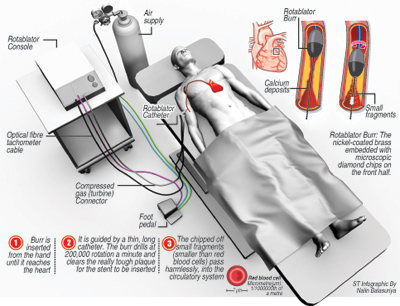Rotablator, the calcium build-up buster
Just walking from his home to the main road, a distance of only about a kilometre, A.A. Chandrasena, 60, would have to stop three times along the way. Struggling for breath, he would feel as if his chest was being squeezed tightly. There would also be a strong burning sensation in his chest.

Dr. Tanya Pereira
That was exactly a year ago and just this week (on Monday) he was back at work as a machine operator, having undergone a “first” in the country. Yes, Mr. Chandrasena did have three blocked vessels which could very well have caused serious illness and even a fatal heart attack.
But what made him different to hundreds of people who have had by-passes was that not only were there three blocks but one was difficult to penetrate, for the heart doctors faced a calcium build-up. To clear the calcified block which was “like hardened cement” the “tool” that was used for the first time in Sri Lanka at the Asiri Surgical Hospital at Narahenpita was the Rotablator, MediScene learns.
It acts like a burr or ‘burume’ as we call in Sinhala, explains Consultant Cardiologist Dr. Vajira Senaratne, giving the medical term as “de-bulking”. Up to the time that the Rotablator was used on Mr. Chandrasena, anyone who was diagnosed with chronic occlusion of a vessel would either have to undergo open heart surgery or go abroad for advanced keyhole surgery, he says.
In the early days blocked coronary arteries were overcome by major open-heart surgery, with the patient being left with a long scar across the chest.
This was followed by angioplasty or keyhole surgery, as an alternative, where a catheter with a balloon at its tip is inserted into a small incision in the groin or the wrist and is guided through the aorta into the coronary artery affected by plaque build-up or cholesterol deposits. When the balloon is inflated it opens up the narrowed artery by pushing the plaque against the wall.
The next advancement came in the form of a stent, a small spring-like device which served like a scaffolding to keep the artery open and the blood flowing to the heart muscle. Last year, when Mr. Chandrasena felt all these symptoms which indicate “angina” and went to Consultant Cardiologist Dr. Mohan Jayathilake, he had ordered an angiogram.

Dr. Mohan Jayathilake
The angiogram found three blocks – soft plaque build-up in two but with chronic occlusion in the third. With a decision being taken to stent two vessels (as the block in one did require stenting), Mr. Chandrasena had undergone the first procedure on January 15, this year.
Of the two, however, vam peththa nahare gal wela thibbe, says Mr. Chandrasena adding that it was then that he was asked whether he would like to undergo the Rotablator procedure. This procedure was done on September 20, says Dr. Senaratne, with the team also including Dr. Jayathilake and Consultant Cardiologist Dr. Tanya Pereira.
Sometimes, in angioplasty, we find that some vessels cannot be opened up to their optimum level through ballooning because of calcification. It could also result in a clot forming (thrombosis) or the vessel re-narrowing, says Dr. Senaratne, stressing that then the purpose of the procedure is lost. “It can also be dangerous.”

Dr. Vajira Senaratne
Defining what ‘Rotablator’ means, he says it is a rotation ablator. A ragged and irregular surface of a vessel indicates calcium deposits, with the raggedness being due to calcium jutting into the lumen. Therefore, when a balloon is inserted, it may break or may not be able to cross the area affected by plaque.
It is then that the Rotablator is used for de-bulking, which is shaving off the calcium deposits to make the vessel smooth, after which the stenting is done. The tiny particles shaved off by the Rotablator are washed off by the blood, MediScene understands.
Of course, the medical team has to be very skilled as the Rotablator if not handled with care can perforate the vessel.



